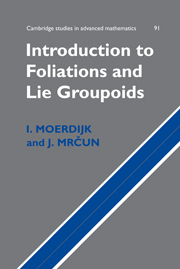4 - Molino's theory
Published online by Cambridge University Press: 02 February 2010
Summary
In Chapter 2 we introduced the notion of a Riemannian foliation: this is a foliation whose normal bundle is equipped with a metric which is, in an appropriate sense, invariant under transport along the leaves of the foliation. In this chapter we study some special classes of Riemannian foliations, and some ways of constructing them, with the ultimate goal of proving Molino's ‘structure theorem’.
The most important class of Riemannian foliations in this chapter is that of transversely parallelizable ones. While an ordinary manifold is called parallelizable if its tangent bundle is trivial, a foliated manifold is called transversely parallelizable if its normal bundle is trivial, and if moreover a trivialization exists which is invariant under transport along the leaves. Intuitively speaking, these are the foliated manifolds whose ‘space of leaves’ is parallelizable.
A special class of transversely parallelizable foliations (to be discussed in Subsection 4.3.1 below) are the so-called Lie foliations. These are foliations defined as the kernel of a ‘Maurer–Cartan’ differential 1-form with values in a Lie algebra.
Another way of obtaining transversely parallelizable foliations, to be discussed in Subsection 4.2.2, is by pulling back a given Riemannian foliation on a manifold M to a suitable transverse frame bundle over M. This construction will form an important ingredient for Molino's structure theorem.
- Type
- Chapter
- Information
- Introduction to Foliations and Lie Groupoids , pp. 81 - 109Publisher: Cambridge University PressPrint publication year: 2003

